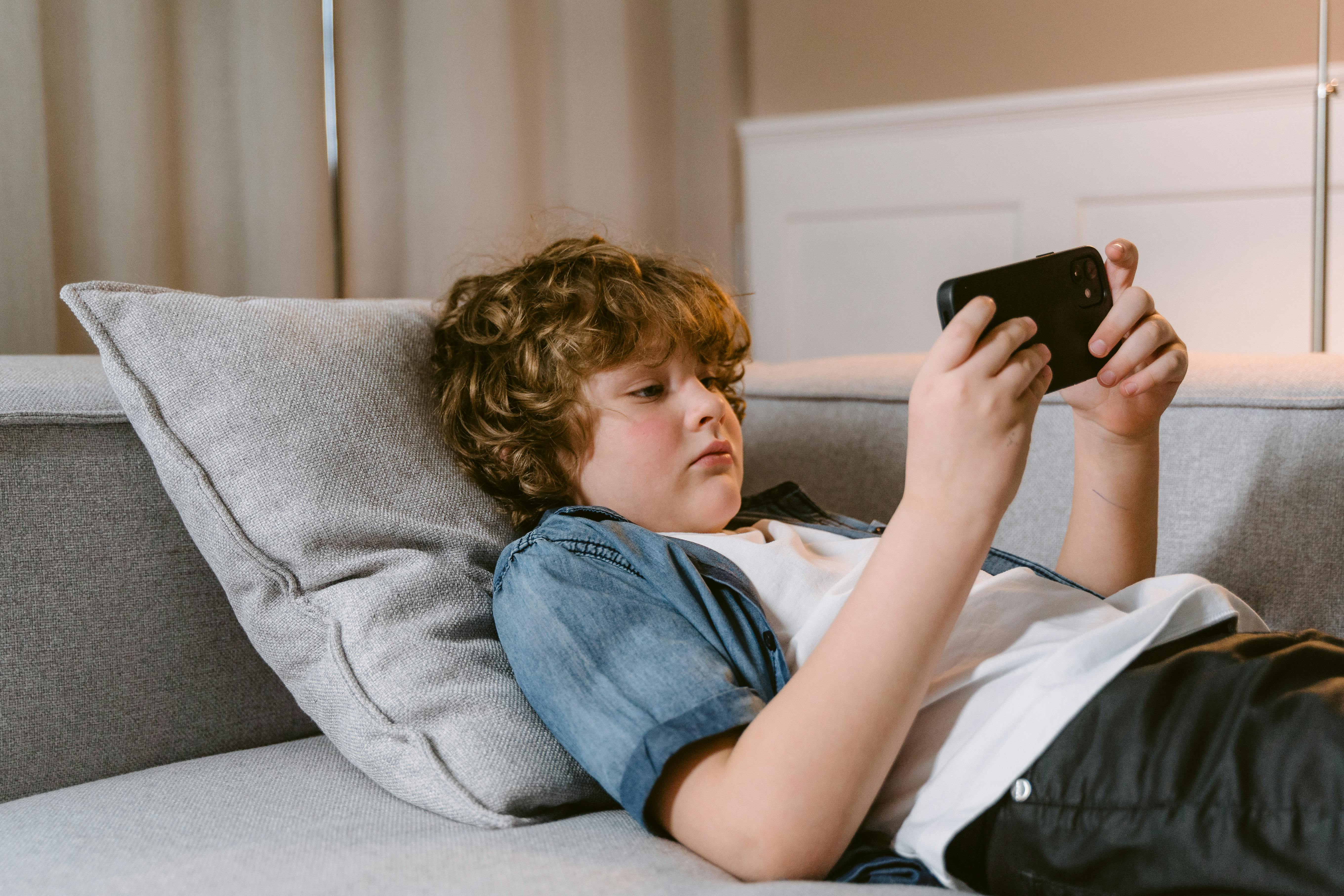Shorouk Express
Get the free Morning Headlines email for news from our reporters across the world
Sign up to our free Morning Headlines email
Sign up to our free Morning Headlines email

For Matthew Tavender, head of schools at Cunningham Hill primary schools, the problem wasn’t children using their phones during school hours, it was the pervasive influence of social media when his pupils left the classroom.
“We were dealing with the fallout on Monday morning”, he explains. “In the past 10 years that smartphones have been around, I’ve not heard one in school. But what we were seeing was the damage smartphones were having outside of school, and the impact of that inside”.
Last May, his primary school – along with 32 others in St Albans, Hertfordshire – decided to address the problem themselves. They sent out a joint letter to families, declaring their schools smartphone-free and urging parents not to give their children the devices until at least the age of 14.
The benefits, Mr Tavender says, have been clear to see.
A check-in before Christmas to assess smartphone use among his pupils revealed that just seven per cent of year 6 pupils have a smartphone, down from 68 per cent the year before.
“Our older children, who would have had a smartphone but now don’t – their attention is much better,” Mr Tavender says. “There is a definite improvement in their relationships. They talk more, play more, whereas a lot of our year 6s (aged 10 or 11) were quite sedentary before.”
Research from regulator Ofcom last year found that children aged eight to 11 are more likely to own a smartphone than not, with 59 per cent having them.
Once children go to secondary school, this is almost universal. At Cunningham Hill Schools, they had some children in year 3 (aged seven or eight) with their own smartphones, and this was not uncommon.

open image in gallery
Ofcom found that around a quarter of five-to-seven-year-olds have a smartphone. Usage of social media apps and messaging tools is also increasing year-on-year for primary school-age children, and a recent YouGov poll found 23 per cent of children aged eight to 15 spend more than four hours a day using screens.
Before Cunningham Hill took action, staff were seeing a lot of problems coming from WhatsApp use, Mr Tavender says.
“That was the biggest cause of bullying and issues with friendship in the school,” he explains. “WhatsApp groups were getting bigger and bigger, some had about 90 people in, and half of them weren’t in our school.
“The interactions between our children were very negative on there – lots of inappropriate language, inappropriate pictures being shared. Nothing sexual, but there were comments on violence and race and things like that.
“We were having a number of our year 6s talking about Andrew Tate, and certainly some of the boys revering who he was.”
Twenty years ago, if children fell out in the playground, they could remove themselves from the fight at the end of the school day. Now grievances follow them home through instant messaging apps, Mr Tavender explains.
While issues generated from children’s social media use have reduced significantly in the first year of the experiment, they haven’t disappeared completely, he adds.
In October last year, problems cropped up among the small group of children who still had smartphones, with parents having to be warned about inappropriate messages being shared.

open image in gallery
By the time Graham Dill’s 10-year-old son moves into year 6 next year, he’s hopeful that almost none of the class will have smartphones. “Taking something away is a lot harder than not letting people have it in the first place,” he says.
As a parent at Cunningham Hill who also works as a private tutor, Mr Dill has two different perspectives on the impact of smartphones and social media on children.
He tutors children who don’t go to school; some with behavioural issues, others who are too anxious to attend.
Maintaining his pupils’ attention can be tough in a post-smartphone age, he explains: “I’m working with kids from around 13-to-16-years-old and they are extremely distracted.
“It affects their concentration and their ability to take some deep breaths and be present on a task. They need that task to go right immediately, or want other stimulation if it is too boring.
“With one boy, it’s a constant default to take his phone out of his pocket and it is a constant reminder. ‘No, put the phone away’.”
When Cunningham Hill announced to parents that they would go smartphone-free, Mr Dill was delighted. Each year group in the school has a smartphone-free ambassador to relay information to other parents and keep them sticking to the pact.
Mr Dill’s children, George and Thomas, are aged 10 and eight and he believes that if parents get on board when their children are younger it is easier to maintain the pledge to keep them smartphone-free.
“If most people are not doing it [giving their children phones], then it becomes a lot easier,” he explains. “We’re having this battle at the moment with Fortnite. They all want Fortnite and we [Mr Dill and his wife, Rachel] don’t really want them to play that.
“It’s because their friends are playing Fortnite that they want to do it, and I think that’s the same with phones down the line”.
His boys are also starting to recognise the low mood that can be generated from too long spent online. “The comedown is such that they can recognise that they are dysregulated at that point,” he explains. “We’re trying to get them to understand when they need to come off a device”.
Parent ambassadors at the St Albans primary schools have now set their sights on local secondary schools, and are hoping to lobby headteachers to push them to take more action.
_n_S1_E3_00_25_31_20.jpeg)
open image in gallery
Deputy head of Queens Park Community School in London, Paul Drummond, has three children at a secondary school in St Albans. Their school, Samuel Ryder Academy, allows students to bring phones to school, but they shouldn’t be seen in lessons, and shouldn’t be for personal use on site.
At Queens Park, the policy is stricter. Children are not allowed smartphones in years 7, 8 or 9. At key stage 4, pupils are allowed them but they can’t be seen on the school site. At key stage 5 or A levels, students are allowed their phones, but they shouldn’t be seen and can be used in lessons only when the teacher allows it.
He explains: “Since we’ve banned phones from being on site at key stage 3, the expectation is that if students need a phone so parents can track them, they should use an old Nokia.
“One of the problems with that is that there can be racial stereotyping of children with old Nokias, with members of the public thinking they are burner phones. Some of the parents are very worried about that.
“But since we’ve banned phones at key stage 3, the safeguarding issues, bullying, and other problems have been reduced quite significantly,” Mr Drummond says.
“We agonised over banning them. We’ve got quite a large site and at break time it’s a much happier place now there’s no phones.”
A recent survey of more than 15,000 schools found that 99.8 per cent of primary schools and 90 per cent of secondary schools have some form of phone ban.
Academics at the University of Birmingham also concluded in a study published in February that just banning smartphones in schools doesn’t improve children’s grades or wellbeing, or reduce their overall phone use.
Instead, they argued that any bans need to be part of a wider strategy to lower phone use among students.
As a parent, Mr Drummond has experienced the difficulties of trying to reduce the family’s social media use. A plan to have no screen time together during the evening, and a ban on phones going upstairs, went out of the window when Covid hit, he says.
-2-April-2025-00-16-01.png)
open image in gallery
In his view, restricting phone access should be coupled with education about usage for both his children and pupils. His school has introduced a tutorial every week for the whole school on the big news stories of the week, which is teaching children discernment, Mr Drummond says.
“We spent 20 minutes discussing the news story, where it came from. We talk about misinformation, reliability and the importance of developing an opinion and political engagement.
“The bottom line is that if someone has access to the internet, they can look at anything they want to really. So we’re trying to get people to understand the perils but also to understand why it is great to look things up and find things out.”
Ofcom research has found that children’s engagement with news and current affairs is low and comes almost exclusively via social media.
Netflix Adolescence has recently sparked national debate over the dangers of children’s access to digital spaces.
The series follows 13-year-old Jamie Miller, whose exposure to misogynistic online communities may have contributed to his killing a female classmate.
While prime minister Sir Keir Starmer has supported the screening of Adolescence in schools, he has said that a government-led phone ban is “completely unnecessary”.
For Mr Tavender, stricter measures from government would be very helpful.
“If the government were to say we are banning phones, then it would make it very easy to get that message across, because that is just the way it is,” he says.
He’s against a “postcode lottery” where some schools have stricter measures than others: “It should be a national decision like in other countries, to ban phones and social media for children. From an education point of view, we are crying out for that support.”
In the meantime, he’s keen to keep the grassroots movement going and persuade local secondary schools to also ask parents to delay giving their children smartphones.
The school is also trying to go beyond phone use and convince more of their students to get outside, and encourage outdoor play.
Mr Dill feels the same. While he’s been encouraged by the changes that St Albans primary schools have made, he wants politicians to get on board.
“I think rather than bottom up it, needs to come from top down, but I guess we won’t see that until we have enough people from the bottom raising their hands and saying they want things done,” he says.





















